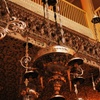Disclaimer
This entry contains information known to us from a variety of sources but may not include all the information currently available. Please be in touch if you notice any inadvertent mistakes in our presentation or have additional knowledge or sources to share. Thank you.
Archive
Moshe Nahon Synagogue at Tangier, Morocco
"Tucked away behind a nondescript door, the Moshe Nahon reveals a lavish and monumental synagogue in the characteristics of synagogues in northern Morocco," begins a description of the Moshe Nahon Synagogue that ranks it as one of the most beautiful synagogues in Morocco.1 The synagogue, located in Tangier, was built in the 1870s; after falling into disrepair in the late twentieth century, it was renovated in 1994 into the beautiful building it is today. The walls and ceiling are covered with intricate carvings, illuminated by hanging lamps.
Description
History: The synagogues of Tangier are located in the city's mellah, mostly on the appropriately-named Synagogues Street--which was recently renamed Synagogue Street, as the Moshe Nahon Synagogue is the only one that remains open.2 The synagogue was built by Moshe Nahon, a banker and active member of the Tangier Jewish community, in 1878.3 Although it fell into disrepair in the late twentieth century, a Jewish architect renovated it in 1994 and today it is one of the few open synagogues in Tangier.4 The synagogue has a separate entrance for women, as well as an upper gallery. The walls follow a Spanish tradition in ornamentation, covered with calligraphy and floral designs in the Mujedar style.5
Tangier: The Jewish presence in Tangier was limited until the late 17th century, when the Muslims regained control of the city from the English. The local economy did not recover from the destruction caused by the English until the eighteenth century, by which time the Jewish population had grown more numerous. The English doctor William Lempriere noted in 1789 that "the Moors and the Jews live intermixed in Tangier, and maintain a more friendly intercourse than elsewhere in this quarter of the globe".6 By 1856, Tangier had become the largest port in Morocco. In that time, the Jewish community had established schools, hospitals, and other charitable works, as well as participating in civic groups such as the Comission of Hygiene.7 In 1925, Jews were assigned three of the twenty-six seats on the International Legislative Assembly, Tangier's governing body, giving them a certain amount of formal political power.8 The aftermath of World War II proved to be a golden age for Tangier's Jews, many of whom lived prosperous and cosmopolitan lives, but Moroccan independence in 1956 led to slow but steady emigration. As of 2007, less than one hundred Jews remain in Tangier.9
Eyewitness Description: A description of the Moshe Nahon Synagogue in 1999, five years after renovation: "A small, unobtrusive door opens on to a narrow alleyway that in no way hints at the monumental size of the synagogue itself. Like most synagogues in Tangier, it is rectangular, and divided by pillars into three naves. A wall painting of the tablets of the law and a crown appear above the ark on the eastern wall, similar to Ketubot (marriage contracts) in synagogues in Gibraltar. A large sculpted wooden lectern is placed near the eastern side. The only exception to the Tangier model is the Nahon synagogue where the tevah(lectern for Torah reading) is placed in the centre of the southern wall. The walls are painted sky blue or yellow and verses from the Bible mentioning the name of the donor of the synagogue are inscribed on them."10
Sources
[1] Kessir, Athmane. "Top 5 Beautiful Synagogues in Morocco." Morocco Holidays Guide. April 16, 2014. Accessed July 24, 2014. http://www.morocco-holidays-guide.co.uk/top-5-beautiful-synagogues-morocco/
[2] Amar, Ariella. "Moroccan Synagogues: A Survey." Israeli Ministry of Foreign Affairs. February 3, 1999. Accessed July 24, 2014. http://archive.today/16Y5#selection-1243.0-1247.214
[3] The Sephardic Journey. New York: Yeshiva University Museum, 1992. Accessed July 24, 2014. http://books.google.com/books?id=-6ltAAAAMAAJ
[4] Kessir. "Top 5 Beautiful Synagogues in Morocco."
[5] Maghraoui, Driss. Revisiting the Colonial Past in Morocco. London: Routledge, 2013. Accessed July 14, 2014. http://books.google.com/books?id=wohfaYvYYiIC
[6] Miller, Susan Gilson. Encyclopedia of Jews in the Islamic World. "Tangier." Brill Online, 2014. Accessed July 14, 2014. http://0-referenceworks.brillonline.com.luna.wellesley.edu/entries/encyclopedia-of-jews-in-the-islamic-world/tangier-COM_0020930
[7] Ibid.
[8] Ibid.
[9] Ibid.
[10] Amar. "Moroccan Synagogues: A Survey."



![Moshe Nahon Synagogue, Ceiling Detail [1] (Tangier, Morocco, 2011)](https://cdn.filestackcontent.com/bt1hXUPsTDOet2QgqZgs/convert?w=100&h=100&fit=crop)
![Moshe Nahon Synagogue, Mellah street [1] (Tangier, Morocco, 2011)](https://cdn.filestackcontent.com/17q27m6zRZetxZUXWBnt/convert?w=100&h=100&fit=crop)
![Moshe Nahon Synagogue, Mellah street [2] (Tangier, Morocco, 2011)](https://cdn.filestackcontent.com/jc4gtuFeRcmTys6bbrsK/convert?w=100&h=100&fit=crop)
![Moshe Nahon Synagogue, Mellah street [3] (Tangier, Morocco, 2011)](https://cdn.filestackcontent.com/MAz8932iSlyHK662IYmd/convert?w=100&h=100&fit=crop)
![Moshe Nahon Synagogue, Mellah street and archway [1] (Tangier, Morocco, 2011)](https://cdn.filestackcontent.com/tP7pRV5ITYmbzIcUxWzG/convert?w=100&h=100&fit=crop)
![Moshe Nahon Synagogue, Mellah street and archway [3] (Tangier, Morocco, 2011)](https://cdn.filestackcontent.com/27kJvjMKSfKY1SS3cERx/convert?w=100&h=100&fit=crop)
![Moshe Nahon Synagogue, Door [1] (Tangier, Morocco, 2011)](https://cdn.filestackcontent.com/4EZXoDrBQjGJk5ZtX2id/convert?w=100&h=100&fit=crop)
![Moshe Nahon Synagogue, Mellah street [4] (Tangier, Morocco, 2011)](https://cdn.filestackcontent.com/zGwydMlrTgqTIxnfak1r/convert?w=100&h=100&fit=crop)
![Moshe Nahon Synagogue, Mellah street [5] (Tangier, Morocco, 2011)](https://cdn.filestackcontent.com/LTjmxvKpR3GdZOBttPV8/convert?w=100&h=100&fit=crop)
![Moshe Nahon Synagogue, Stairs to women’s section [2] (Tangier, Morocco, 2011)](https://cdn.filestackcontent.com/1HDuEtRRGMjUkWPs9Lww/convert?w=100&h=100&fit=crop)
![Moshe Nahon Synagogue, Stairs to women’s section [3] (Tangier, Morocco, 2011)](https://cdn.filestackcontent.com/TL3GnQoRTy1cP62OxWHZ/convert?w=100&h=100&fit=crop)
![Moshe Nahon Synagogue, Framed Verses [1] (Tangier, Morocco, 2011)](https://cdn.filestackcontent.com/o0TEBQYURXizkkw0Mcpf/convert?w=100&h=100&fit=crop)
![Moshe Nahon Synagogue, Framed Verses [2] (Tangier, Morocco, 2011)](https://cdn.filestackcontent.com/jIc1slzFQYeaEtlsewST/convert?w=100&h=100&fit=crop)

![Moshe Nahon Synagogue, Framed Verses [3] (Tangier, Morocco, 2011)](https://cdn.filestackcontent.com/kKFuBXvyTseceYv9Pyrr/convert?w=100&h=100&fit=crop)
![Moshe Nahon Synagogue, Framed Verses [4] (Tangier, Morocco, 2011)](https://cdn.filestackcontent.com/gTYcGgdbQvaNHRbIRnTI/convert?w=100&h=100&fit=crop)
![Moshe Nahon Synagogue, Framed Verses [5] (Tangier, Morocco, 2011)](https://cdn.filestackcontent.com/Dr8T9X7HROO86zn8u8gu/convert?w=100&h=100&fit=crop)
![Moshe Nahon Synagogue, Framed Verses [6] (Tangier, Morocco, 2011)](https://cdn.filestackcontent.com/znnXTV1TxOnabgxwavVD/convert?w=100&h=100&fit=crop)
![Moshe Nahon Synagogue, Framed Verses [7] (Tangier, Morocco, 2011)](https://cdn.filestackcontent.com/ldlOj3TXR6Wu8B5e9eDB/convert?w=100&h=100&fit=crop)



![Moshe Nahon Synagogue, Door [2] (Tangier, Morocco, 2011)](https://cdn.filestackcontent.com/nO08uK5YQuuRN9Yicmwd/convert?w=100&h=100&fit=crop)


![Moshe Nahon Synagogue, Interior [1] (Tangier, Morocco, 2011)](https://cdn.filestackcontent.com/peq2qqYSy6Rmeum5FVgi/convert?w=100&h=100&fit=crop)


![Moshe Nahon Synagogue, Interior [2] (Tangier, Morocco, 2011)](https://cdn.filestackcontent.com/OHVnCLOJTO2m7fq70HK2/convert?w=100&h=100&fit=crop)
![Moshe Nahon Synagogue, Ceiling Detail [2] (Tangier, Morocco, 2011)](https://cdn.filestackcontent.com/WVOZardRSz6rfSEmwyNQ/convert?w=100&h=100&fit=crop)

![Moshe Nahon Synagogue, Interior [3] (Tangier, Morocco, 2011)](https://cdn.filestackcontent.com/7XQhm9ZOSWqhkJ6zJCh6/convert?w=100&h=100&fit=crop)
![Moshe Nahon Synagogue, Chandeliers [2] (Tangier, Morocco, 2011)](https://cdn.filestackcontent.com/2tabi0pPS5eT2EHdmcgZ/convert?w=100&h=100&fit=crop)
![Moshe Nahon Synagogue, Mellah street [6] (Tangier, Morocco, 2011)](https://cdn.filestackcontent.com/GyhA2MMITlOWO8WMIIQO/convert?w=100&h=100&fit=crop)

